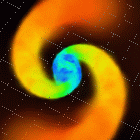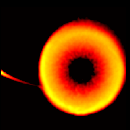UKAFF 'movies"
UKAFF movies & pictures
The following movies were produced from simulations performed on the
UKAFF computer.
|
Notes on playing the movies
Windows users are recommended to use the latest version of Windows
Media Player (version 7 or better) to play movie clips.
QuickTime clips should be played using the QuickTime player (available
for both Windows and Apple Mac).
Unix users are recommended to use XAnim (with all appropriate codecs installed) to play AVIs.
|
|
Notes for users of Windows XP SP2
With the release of Windows XP Service Pack 2 (SP2), Microsoft have
changed the behaviour of Windows Media Player in such a way that AVI
files encoded using certain codecs no longer play directly from a
clicked link on a web page. This new feature affects a number of the
movies on this page.
To play such movies you must download them to your local disc
(eg. your C: drive), and play them from there.
|
| |

 |
|
Jets and cooling flows in galaxy clusters
Galaxy clusters contain large volumes of hot gas lying between the
individual galaxies. UKAFF simulations have helped to show that this
gas may be being re-heated by jets of hot gas ejected from the black
holes within active galaxies in the cluster. The different colours in
the image code regions of different density.
More details in the press release, or Volume 418 of the scientific
journal Nature (18th July 2002). Movies of the simulations are available from this web page.
Click on the thumbnails for larger images.
Simulations and images by Marcus Brüggen, International University of
Bremen and Christian Kaiser, University of Southampton.
|
| | | |
 |
|
Formation of a star cluster
A 50 solar mass gas cloud collapses to form a cluster of brown dwarf stars, some with proto-planetary discs.
Movies and images are available here.
|
| | | |
 |
|
Planet-disc interactions
This simulation shows a high-resolution 2D simulation of a Jupiter mass planet starting to clear a gap in a protoplanetary disc.
Available from this page.
Simulations and visualisation by Phil Armitage, University of St. Andrews
|
| |
 |
|
Accretion disc boundary layers
Magnetic field evolution in a high resolution 3D MHD simulation of an accretion disc and boundary layer.
Available from this page.
Simulations and visualisation by Phil Armitage, University of St. Andrews
|
| |
 |
|
Accretion disc in a binary star system
This simulation shows an accretion disc around a white dwarf in a
binary star transient system.
Available formats:
AVI optimised for Windows (8.3MB,
high-quality)
(Users of Windows XP SP2 see notes here)
AVI optimised for Unix (13.9MB,
high-quality)
Simulation performed by Mike Truss, University of
Leicester. Visualisation by Richard West, UKAFF.
|
| |
 |
|
Merging neutron stars
The merging of two neutron stars is thought to play an important role in the formation of elements heavier than iron.
Movies and images are available here.
|
| |
| |
 |
|
A stellar collision
This movie shows a simulation of a collision between a red giant and a
white dwarf.
When two stars collide they may merge to form a single
massive object, or if they hit each other a high speeds they may break
each other apart altogether. If the stars have very different sizes the
smaller star may plough through the larger, throwing off some of the
material.
Movie available as AVI (17MB,
moderate quality) and QuickTime (91MB, high
quality).
Available as an animated GIF for users without movie playing software.
Simulation performed by Matthew Bate, Institute of
Astronomy, Cambridge on the UKAFF computer.
|
| |
| |
 |
|
The magnetic Cataclysmic Variable "EX Hya"
In the binary star system EX Hydrae the two stars are orbiting so
close that matter is stripped from the larger (though less massive)
star and falls onto its more massive white dwarf companion.
The white dwarf in this system has a magnetic field which is so strong
that it
disrupts the stream of gas drawn from the companion and funnels it
toward the nearest magnetic pole. As the white dwarf rotates with
respect to its companion the stream "flip-flops" between the two poles.
Movie available as AVI (17MB,
moderate quality) and QuickTime (36MB, high
quality).
(Users of Windows XP SP2 see notes here)
Available as an animated GIF for users without movie playing software.
Simulation performed by Graham Wynn, University of Leicester. Visualisation by Richard West, UKAFF.
|
| |
| |
 |
|
Soft X-ray transient
This simulation shows an accretion disc around a black hole in a soft
x-ray transient system. As gas in the disc is accreted into the black
hole, the emitted radiation heats the inner regions of the disc, causing
even more gas to be accreted. This produces the large outburst which can
be seen in the simulated light-curve at the bottom. As the outburst
progresses, the density of the disc (shown on the left) falls rapidly
inside the heated radius (red) while the emissivity (on the right) in this
region simultaneously increases (yellow).
Movie available as AVI (21MB)
Available as an animated GIF for users without movie playing software.
Simulation performed by Mike Truss, University of
Leicester. Visualisation by Richard West, UKAFF.
|
The UKAFF computer

Professor Andrew King alongside the UKAFF computer
Stock OHP slides for presentations
Those giving presentations about UKAFF might like to use the following
stock OHP slides slides describing the UKAFF project:
|